The Arts on the Stamps of the World — February 25
An Arts Fuse regular feature: the arts on stamps of the world.
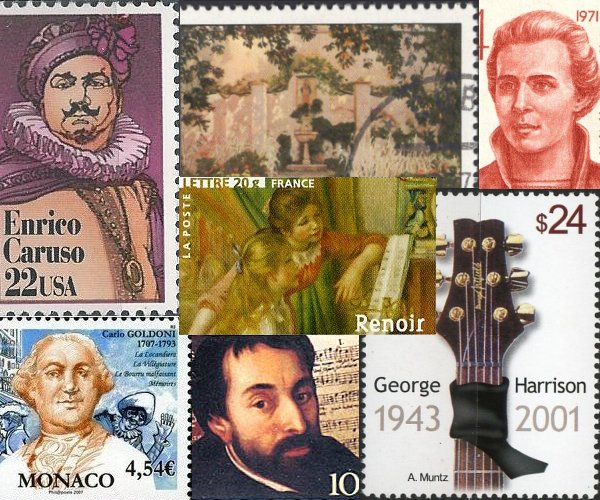
By Doug Briscoe
The number of creative artists who have a birthday today and are also represented on stamps of the world is just insane. I found seventeen—actually eighteen, since “one” of them is twins—plus a Dutch painter whose birthdate is unknown but who was buried on this day. So I must perforce keep the biological blurbs brief today or risk a bad case of typewriter’s cramp and the exhaustion of your endurance.
The most celebrated people born on February 25 are Auguste Renoir, Enrico Caruso, and George Harrison; second-tier, I suppose, would be Carlo Goldoni, Karl May, Zeppo Marx, Gert Fröbe, and Sean Astin. As for the rest, read on if you have the stamina for it!
Pierre-Auguste Renoir (25 February 1841 – 3 December 1919) is an extremely popular topic for stamps. I decided to use a beautiful set from the Isle of Guernsey as the centerpiece of our Renoir collage, surrounding it with individual stamps from France, Russia, and Wallis and Futuna. I had to exclude a great many more.
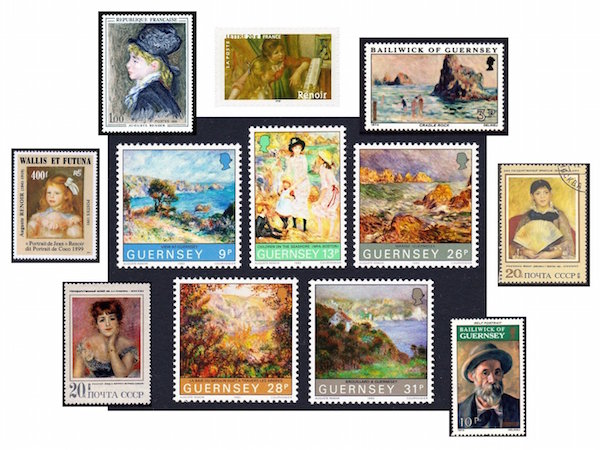
Enrico Caruso (1873 – 2 August 1921) was born in Naples, went to La Scala in 1900 and the Met in 1903. Just the day before yesterday I showed a Nicaraguan stamp with Caruso in the rôle of Eléazar to mark the anniversary of the first performance of Halévy’s La Juive. Today we add three more Caruso stamps, from the United States, Italy (of course), and Bulgaria. Caruso died in the city of his birth, aged 48, apparently of peritonitis.
George Harrison (1943 – 29 November 2001) appears on any number of Beatles stamps and souvenir sheets from around the world. I choose to show just two: one British stamp the design of which simulates a stack of album covers on a stack of stamps, with an eye-fooling irregular perforation, and one sweet memorial stamp issued by Uruguay after Harrison’s death from cancer.
18th-century Italian librettist Carlo Osvaldo Goldoni (1707 – 6 February 1793), is best remembered for his many plays (about 150), mostly comedies, but he also wrote over 50 opera and intermezzo libretti, some of which were set by such composers as Galuppi, Piccinni, and Paisiello. Two of them were used by Haydn: Lo Speziale and Il mondo della luna. I present Goldoni stamps from Italy (of course), Bulgaria, Romania, and Monaco.
Karl Friedrich May (1842 – 30 March 1912) wrote adventure novels set in the American Old West that were read and loved by thousands of German boys. One of them was the late Gunther Schuller, who told me how much he had enjoyed the books during his own boyhood years in Germany (though Gunther was born in the U.S.). If you’ve seen the Quentin Tarentino film Inglourious Basterds, you may recall the “Who Am I?” game-playing scene in which one of the characters wins by guessing the identity of a Karl May character: “Ich bin Winnetou, Häuptling der Apache.”
Third collage, top row: On a more sober note, Friedrich Spee (1591 – Trier, August 7, 1635) was a courageous and wise German Jesuit, teacher, and poet, who denounced witchcraft trials and the use of torture in general, as put forth in his Cautio Criminalis (Precautions for Prosecutors, 1631). He also gave his life in service to the sick when he contracted an infection while ministering in a hospital. Leibniz greatly admired Spee’s Golden Book of Virtues; this and a book of religious lyrics, Trutznachtigall, which I think means The Defiant Nightingale, were not published until after Spee’s death. The stamp shows a sheet of music because Spee wrote the lyrics to a number of hymns.
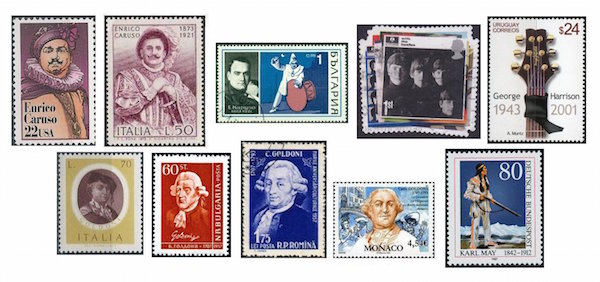
The Portuguese poet Cesário Verde (1855 – 19 July 1886) lived his brief life in obscurity and even today is not universally known, although he is held in very high regard in his native land, where his works are widely taught in schools. Verde published about forty poems in periodicals during his lifetime. Much of his work is tinged with melancholy, which is in part attributable to the early death from tuberculosis of his dear sister. The same disease would claim his life fourteen years later. His posthumous reputation was encouraged by Fernando Pessoa.
It is with his paintings that we salute Santiago Rusiñol i Prats (1861 – 13 June 1931), though he was also a playwright, poet, and author of books on travel. Rusiñol was born in Barcelona and went to Paris in 1889. Back in Spain, he established a studio in the small town of Sitges and, in Barcelona, met and influenced the young Picasso. There does not appear to be a Spanish stamp for him, but I found a couple of his paintings on stamps issued by Cuba because those works hang in that country’s National Museum of Art. Rusiñol also painted portraits of Utrillo and Erik Satie. His Wikipedia article gives us a further eleven canvases to enjoy.
Third collage, second row: One of the most distinguished of Ukrainian writers was Lesya Ukrainka (born Larysa Petrivna Kosach-Kvitka; February 25 [O.S. February 13] 1871 – August 1 [O.S. July 19] 1913). Her mother, also a writer, set the tone for her daughter’s life as an activist for women’s rights, as well as a proponent of the preservation of the Ukrainian language in opposition to the government-imposed advocacy of Russian. Lesya was only 13 when her first poem, in Ukrainian, was published, and she continued all her life a proud defender of Ukrainian culture and a feminist activist. A brilliant linguist, Ukrainka (oo-kra-IN-ka) knew ten languages and loved travel, going as far as Egypt. She also wrote plays, criticism,and sociopolitical essays. Her picture has been on the Ukrainian 200-hryvnia banknote since 2007.
Czech composer Otakar Ostrčil (1879 – 20 August 1935) lived his entire life in Prague. He held positions as a conductor from 1914 and gave the Prague première of many works by his great contemporaries, including Berg’s Wozzeck in 1926. His own compositional style was most heavily influenced by Mahler, though he turned to neoclassicism toward the end of his life. Ostrčil wrote six operas, a number of orchestral works including a symphony (1906), and some chamber music, including a string quartet (1899).
Zeppo Marx, the fourth Marx Brother, the good-looking one, the straight man, was born Herbert Manfred Marx (1901 – November 30, 1979). He appeared in the first five Marx Brothers movies before turning to engineering. His company made the Marman Twin motorcycle and the clamps that held the “Fat Man” atomic bomb, and Marx also invented a medical pulse monitor and a therapeutic heating pad. Younger members of our readership may need to be informed that he is third from the left in this Marx Brothers stamp from the Gambia.
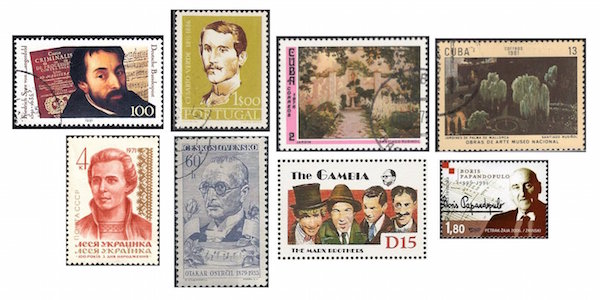
Composer Boris Papandopulo (1906 – October 16, 1991) was also a conductor, leading two choruses in Split, the Croatian Radio Symphony Orchestra, and opera at the Croatian National Theatre and in Rijeka. His father was a Greek nobleman and his mother the opera singer Maja Strozzi-Pečić, and he was partly of Russian Jewish descent. Papandopulo was quite a prolific composer of some 440 works: music for the stage, orchestral works, chamber music, sacred and secular choral pieces and songs; in these he made use of various influences from folk music to jazz to dodecaphonism, and he also wrote some popular hits.
Fourth collage, first row: The character of Auric Goldfinger in the James Bond film—“Do you expect me to talk?” “No, Mr. Bond, I expect you to die.”—was memorably played by Karl Gerhart Fröbe, known as Gert Fröbe (1913 – 5 September 1988). He was a violinist in his youth, but gave it up for the theater. Although a member of the Nazi party from 1929 (when he was only 16) to 1937, he hid two German Jews from the Gestapo and was drafted into the Wehrmacht in the final few months of the war. An Israeli ban on Goldfinger was lifted when a Jewish family came forward to thank him for saving their lives.
Belgian jazz guitarist René Thomas is yet another February 25 baby. Born in Liège in 1927, he started making records in 1943, later becoming friends with Bobby Jaspar. He went to Paris, then Canada, and made an album with Toshiko Akiyoshi in the U.S. Like Jaspar, he died of a heart attack at a young age, 47, on 3 January 1975.
I confess I’d never heard of the Australian rock band Magic Dirt until I encountered this stamp for the group just a few weeks ago. One of the founding members of the band is guitarist and vocalist Adalita Srsen, born on this day in 1971, who has since put out a couple of solo albums. Her father is Croatian, and she has taken to using just “Adalita” as her stage name.
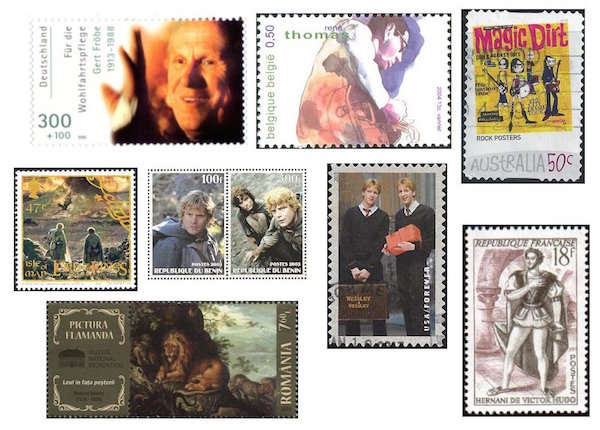
Fourth collage, second row: Our next birthday boys would, frankly, not be on stamps at all if not for the enormous popularity of the films in which they appeared. Sean Astin, born on exactly the same day as Adalita, is the son of the late Patty Duke. He has had a long career on screen, but is probably best known (so far) for his performances as Samwise Gamgee in Peter Jackson’s Lord of the Rings films. These have been represented on stamps from New Zealand, where the films were largely shot, and by other countries seeking to cash in. He can be vaguely discerned (on the left) on a stamp from the Isle of Man, and much more clearly seen on two stamps from a sheet from Benin. Similarly, the twins James and Oliver Phelps (born 1986) have achieved some notoriety for playing the brothers Fred and George Weasley in the Harry Potter film series. Their stamp comes from the same US issue I cited just days ago for the birthday of the late Alan Rickman.
Fourth collage, bottom row: It’s not his birthday, but Dutch painter Roelant Savery (or Saverij, born 1576) was buried on this date in 1639. He received early training from his brother Jacob (1566–1603) and from Hans Bol (1534–1593). Savery became court painter for the Holy Roman Emperors Rudolf II and Mathias at Prague and was later one of the most successful painters in Utrecht. One of his students, despite the great discrepancy in their styles, was Allaert van Everdingen. Savery was primarily a landscape artist, his pieces often teeming with wildlife, with a number of his pictures including images of the long-extinct dodo bird. The stamp, which shows The Lion before his den, is from Romania, as the picture hangs in the centuried Brukenthal Museum, which happens to have been opened to the public exactly 200 years ago this year.
Well, OK, since you insist, just one more. Victor Hugo’s play Hernani (later made into an opera by Verdi) had its first performance on 25 February 1830 in Paris. Hugo’s birthday is tomorrow. Now will you kids go to bed?
A graduate of the University of Massachusetts with a B.A. in English, Doug Briscoe worked in Boston classical music radio, at WCRB, WGBH, and WBUR, for about 25 years, beginning in 1977. He has the curious distinction of having succeeded Robert J. Lurtsema twice, first as host of WGBH’s weekday morning classical music program in 1993, then as host of the weekend program when Robert J.’s health failed in 2000. Doug also wrote liner notes for several of the late Gunther Schuller’s GM Recordings releases as well as program notes for the Boston Classical Orchestra. For the past few years he’s been posting a Facebook “blog” of classical music on stamps of the world, which has now been expanded to encompass all the arts for The Arts Fuse
